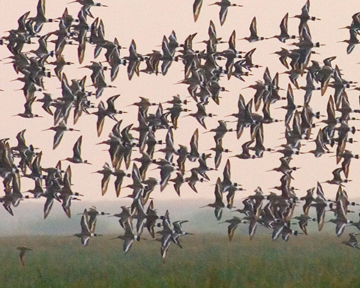Nature and the magnetic compass
Blue light and a special protein help birds use the earth’s magnetism to find their way, says S.Ananthanarayanan.

That birds and many living organisms use the earth’s magnetic field to orient behaviour has been known for decades. But what could be the physical basis
for such sensitivity has been elusive. One possibility is that birds have magnetic material embedded in their heads to help the bird sense magnetic force. The other theory is that the body has chemical agents which are sensitive to magnetism. Evidence has
been found for both.
Pigeons follow nose
The homing pigeon has remarkable sense of direction. Pigeons can remember pathways that do not depend on visual signposts - for instance, getting to
their ‘home’ rooftop even when landmarks are pulled down. They can do it when the sun shines from different directions at different times of the day or when it is overcast and the sun cannot be seen.
Dr Cordula Mora and her team in Aukland, New Zealand found that pigeons actually sense magnetic fields through iron-rich materials found in their beaks.
The birds were placed in a cylinder with a food tray at both ends and an electric coil to create a magnetic field. The birds were rewarded if they followed the field and moved the correct way by placing food on the correct tray. The birds were found to learn
very fast, which means they could clearly sense the magnetic field, as if it were a colour or sound of a particular pitch.
But if small magnets were taped to their beaks, or if the beaks were anaesthetized, the birds did not react to changing the direction of the field. This
showed that it was in the beak that the birds had their magnetic field sensing equipment.
Sensitive to light
There is also evidence that with many birds, the sensors of magnetic fields is located in the eyes and depends on certain shades of light being present.
This suggests a different mechanism – one where light of specific energies sets off a chemical process which depends on the orientation of the magnetic field. If this process is perceptible to the bird, it could adjust its direction of flight according to
the magnetic field! A paper in Nature, published in July 2008, reports the identification of such a mechanism.
A simple chemical arrangement that is sensitive to magnetic fields is a pair of electrically charged groups of atoms. Molecules
are generally formed by atoms or groups of atoms which mutually borrow and lend charged particles, to get both groups into a more stable condition – a kind of co-operative co-existence. But the partners also get separated sometimes, and they float in their
‘more stable’ state, but with a net charge so long as they are separate. Such free-floating charged segments of groups of atoms are called
radicals and a pair of them would be a
radical pair.
Pairs of radicals are then lightweight but important players in chemical reactions and they have strong magnetic properties. Because they are magnetic,
a magnetic field could orient them to react in one way when the field is strong and another way when the field is weak. The radicals would then go for one chemical reaction in one kind of magnetic field and for another reaction when the field is different.
If the different reactions could affect the light sensitivity of the eye, differences in magnetic fields may be perceived in some visual manner!
[the writer can be contacted at simplescience@gmail.com]